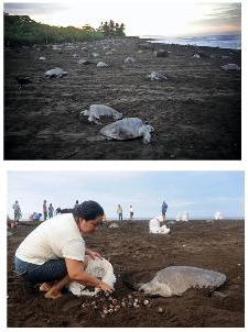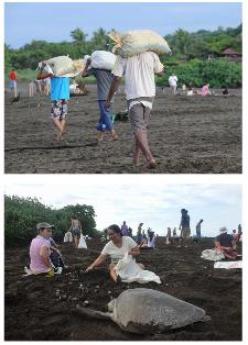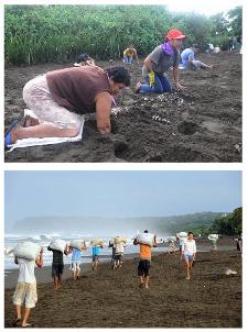The Turtle or the Egg? - Shelly Palmer - MediaBizBloggers

In a world with a billion computers, four billion cellphones and a robust global Internet, the truth can sometimes be hard to find. There is a quote attributed to Senator Daniel Patrick Moynihan that I am using more and more these days, "… you are entitled to your own opinion, but you are not entitled to your own facts." We can all offer many examples of reports and accounts where the blurring of fact and opinion are "business as usual." Sadly, it is becoming all too common.
It is now quite obvious that we are going to need better ways to verify our information. There is too much of it, and because we (as media consumers) have so much control over the media we consume, we can inadvertently cocoon ourselves in the comfort of only the information we wish to hear. Why listen to the opposition? Simply listen to your thought leader's interpretation of the opposition. You can select your filter and only receive the media that you allow to pass through it: print, text, audio, video and, to some extent, even television. This has always been true for tightly ruled communities, but they used territorial or even totalitarian methods to achieve media isolation. I don't think any society has ever been technologically empowered to achieve self-selected media isolation at this scale.
Just the other day I received a couple of emails that reminded me that the highly self-serving fact and opinion issues (which are exacerbated by the advent of remarkably powerful social media tools) pales by comparison to the problems caused by non-professional, uninformed, unschooled, inductive interpretation of actual facts.
Here is the body of an email that has been circulating around the Internet:
Sending you an e-mail of the turtles on the beaches of Costa Rica. See the 2nd picture too, where the female cannot cover up her own eggs, before the Intruder steals away what Nature has given her to protect her young. These people have, unfortunately, taught their children nothing for the future generation to cherish. Look at these children and they do not know anything about conservation of Marine Life Protection and look at the disastrous road their parents are taking too ... what have they all gained for the future of Costa Rica's Marine Life protection? World Wide shame in COSTA RICA. Please distribute widely. The Turtle eggs are stolen to be sold. The planet is thankful.
The email was accompanied with a series of 12 pictures. Here is a representative sample:
At first glance, this is a heart-breaking pictorial essay with a narrative that, although poorly written, is impassioned. The writer clearly believes that these people are doing a great wrong and, for those unschooled-in-the-art, it is easy to agree.
However, this narrative is simply one interpretation of the facts in evidence. And, assuming the writer has no first-hand knowledge of the situation, the writer, and most readers, are using some form of inductive reasoning to reach their conclusions.
Here's a copy of the second email I received on this subject:
Please forward this to everybody you sent the sea turtle picture to:
Were these photos of the turtle "egg theft" not accompanied by the message at the bottom that explained that this was really not egg theft but an attempt to blend decent science with local economic development designed to save both the turtles and the local economy from real poachers? Here's a copy that should have accompanied the photos:
The project in Costa Rica is part of a sustainable-harvest project designed to take into account local customs and needs of the population in order to provide ultimately, maximum conservation of the species. Costa Rica is one of the world leaders in wildlife conservation. They have found that total bans and knee-jerk activism aren't always the best ways to improve wildlife conservation.
Please read this and see that the story is more complex:
Scientists found that the turtles come ashore here four or five times over a 10 month period. Each time hundreds of Ridley Turtles arrive in Ostional for a mass egg laying fest, coming to shore in mass nesting events, what are called an arribada, "an arrival". Each turtle lays 100 eggs or more. The event will last for 4 or 5 days and scientists discovered that since eggs deposited by early arrives were being crushed by the next waves of turtles coming to lay eggs, it made sense to allow locals in this area to remove the first wave of eggs, since they were destined to be crushed anyway. It was also realized that eggs laid during the dry season were unlikely to ever hatch due to the heat of the sand, which dehydrated the eggs.
So it was decided to let the towns folk collect and sell the eggs and use the money to help preserve the eggs in the subsequent waves of egg laying. The money was also used to build facilities in town, like schools and a clinic. Some of the money also ends up in the pockets of towns people, providing income where few jobs exist. The collected eggs are sold in bars and stores to meet the demand for turtle eggs and helps discourage poaching of eggs more likely to hatch. By providing a sufficient source of turtle eggs, the price of eggs stays low on the black market, discouraging incentive to poach them. Ridley turtle eggs are about the size of a lime and leathery. They are amazingly tough and can be gathered into large sacks without breaking.
Since 1986 turtle eggs have been legally gathered by an organization know as the Association of Integral Development of Ostional (AIDO). The main goal of the exploitation and marketing of turtle eggs by the Association of Integral Development of Ostional (AIDO) is to achieve social growth of the community through controlled removal of eggs without compromising the reproduction and conservation of the species. The eggs were initially sold through the association but in about 1990 a food purveyor took over distribution on a national basis. Most of the eggs end up in and around the central valley and nearly 90% of them are consumed in bars, often mixed with catsup and a few other lesser ingredients in a beverage known as a sangrita, served with beer.
Dr. Simon C. Nemtzov
Wildlife Ecologist
Is the first email correct? Is the second? I really don't know, so I'll ask you: "Which came first ... the turtle or the egg?"
Shelly Palmer is the host of MediaBytes with Shelly Palmer, a daily show featuring news you can use about technology, media & entertainment. He is the author of Television Disrupted: The Transition from Network to Networked TV (2008, New York House Press) and the upcoming, Get Digital: Reinventing Yourself and Your Career for the 21st Century Economy. (2009, Lake House Press). Shelly is also President of the National Academy of Television Arts & Sciences, NY (the organization that bestows the coveted Emmy Awards). For information about Get Digital Classes, visit http://www.shellypalmer.com/seminars.Watch Digital Life with Shelly Palmer Tuesdays at 10p ET on WNBC's NY Nonstophttp://www.shellypalmer.com/digitallife.
Read all Shelly's MediaBizBloggers commentaries at Shelly Palmer - MediaBizBloggers.
Follow our Twitter updates @MediaBizBlogger





